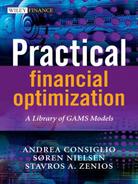Preface
Where the spirit does not work with the hand, there is no art.
This is a book about art: the art of modeling financial decision making using optimization. The science of financial optimization models has been introduced in the companion volume by S.A. Zenios, Practical Financial Optimization: Decision Making for Financial Engineers (Blackwell Publishing, Cambridge, MA, 2007), henceforth abbreviated as PFO.
In this book the reader’s spirit works closely with his hand to create models. The reader is expected to have an understanding of creativity and to possess the skills and tools necessary to illustrate his or her ideas of business reality, finance concepts, and market expectations. The reader who has an unorthodox understanding of the problem is able to create a model that can act as a portal representing the realities of his or her own specific problem. This portal enables the user to perceive things from a decision maker’s perspective, rather than from a broad and abstract perspective. In any event, the model does not teach a precise way of perception. The decision maker must maintain open-mindedness in order to question what has been created by the model, and how that interacts and relates with the decision making problem at hand. The decision maker comes to realize the great number of possibilities that are layered within any model.
Of course these possibilities must be well grounded in currently accepted theories of financial economics, while at the same time they should work well in practice and provide all the ‘bells and whistles’ required by the user. To paraphrase another Da Vinci quote, a good model must be a masterpiece of engineering and a work of art. But these issues were addressed in PFO. The current book leads the reader from the discussion of PFO to functional models implemented in the high-level algebraic modeling language GAMS - a General Algebraic Modeling System - of Brooke, Kendrick and Meeraus (1992). All models discussed in this book are available through the library FINLIB, which can be accessed from http://www.gams.com/finlib. The library provides instantiations of all the models discussed here, complete with market data. Users can readily substitute their own data in a model, or can use FINLIB to find the building blocks for their own models.
All the models in FINLIB can be run on any computer that supports GAMS and, therefore, are absolutely independent from the machine or the operating system. A student version of GAMS can also be downloaded free of charge from the web site. This version provides the full GAMS functionality, so that FINLIB models can be compiled by it. However, size restrictions apply to the number of variables and equations that can be solved. Therefore, large-scale instances of FINLIB models, with many asset classes, time-periods, scenarios, and so on, cannot be solved with the student version.
An explanation of the precise link between PFO, the current book, and FINLIB is in order. PFO introduces the general concepts and theories of financial optimization models that are used by financial engineers; it can be used as an introduction to the subject of financial modeling or as a stand-alone reference. The current book describes technical concepts relating to the implementation of GAMS models and discusses the implementation of several models from PFO, either verbatim or with small technical modifications. However, not all models in PFO are implemented here, although sufficient information is provided so that any additional models can be easily implemented by the reader. It is expected that this book will be used in conjunction with PFO, and references are made herein to PFO using the notation PFO-m.n.p where m.n.p refers to PFO labels. For instance, “Section PFO-6.3” refers to Section 3 of Chapter 6, and “Model PFO-6.4.2” refers to the second model of the fourth section of Chapter 6; readers will easily locate the cited material. Finally, FINLIB provides the software and the data required to instantiate all the models discussed in this book. There is a one-to-one correspondence between the models in the current book and FINLIB, and a strong relationship of all the models in FINLIB with PFO.
Organization of the Book
The organization of the chapters in this book closely follows the structure of PFO, with two introductory chapters, five chapters on optimization models and a chapter with several case studies.
The introductory part consists of Chapters 1 and 2, and gives an introduction to the GAMS modeling system and discusses data management. These chapters can be skipped by readers familiar with GAMS.
The bulk of the optimization models are given in the five chapters corresponding to the PFO chapters on portfolio optimization models; here we also develop one or more GAMS models for each model class. This part is the core of the book. It develops GAMS models for supporting the classic mean-variance analysis in Chapter 3, for fixed-income portfolios in Chapter 4, for scenario optimization in Chapter 5, for dynamic portfolio optimization using stochastic programming in Chapter 6, and for creating indexed portfolios in Chapter 7.
Finally, Chapter 8 deals with case studies and develops GAMS models for diverse real-world applications. The four sections in this chapter develop complete models for all the applications discussed in PFO: international asset allocation, corporate bond portfolio management, insurance policies with guarantees and personal financial planning. The models in this part capture policy restrictions, regulatory requirements, business objectives, and similar practical considerations, and they come complete with real-world data.
..................Content has been hidden....................
You can't read the all page of ebook, please click here login for view all page.
